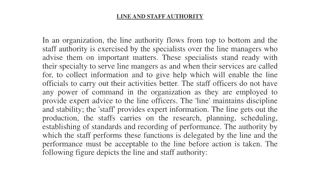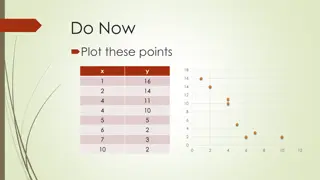Line Follower Challenge
In this challenge, participants utilize color sensors to guide a robot in following a black line using programmed turns. The activity involves understanding color sensor functionality and implementing it to navigate the robot along the specified path.
Download Presentation

Please find below an Image/Link to download the presentation.
The content on the website is provided AS IS for your information and personal use only. It may not be sold, licensed, or shared on other websites without obtaining consent from the author.If you encounter any issues during the download, it is possible that the publisher has removed the file from their server.
You are allowed to download the files provided on this website for personal or commercial use, subject to the condition that they are used lawfully. All files are the property of their respective owners.
The content on the website is provided AS IS for your information and personal use only. It may not be sold, licensed, or shared on other websites without obtaining consent from the author.
E N D
Presentation Transcript
Pre-Activity Quiz 1. How does a color sensor work? Does the color sensor detect white or black as a higher amount of light reflectivity? Absorbance? 2. Can you think of a method to have the robot follow the line using turns? Describe how it would work.
Pre-Activity Quiz Answers 1. How does a color sensor work? Does the color sensor detect white or black as a higher amount of light reflectivity? Absorbance? A color sensor sends out light from one side and uses a sensor next to it to detect the light that comes back after being reflected by the surface the light hits. White objects reflect most of the light whereas dark objects reflect very little light. Thus, a higher reading of the color sensor means that more of the light is reflected. Looking at it another way, darker objects absorb more light so that less is available for being reflected. That is, more absorption means less reflectance. Can you think of a method to have the robot follow the line using turns? Describe how it would work. The two main program commands used are: 1. If the color sensor detects a whitish color, program the robot to turn in a certain direction. 2. If the color sensor detects a darkish color, program the robot to turn in the opposite direction. With this technique, a robot can be made to follow the edge of a line. 2.
Line-Follower Challenge 60 minutes To have the robot follow a black line. First, let s review how the color sensor works. Then attach a color sensor using the instructions in the LEGO base set manual. Then, create a program that uses the color sensor to make it follow the black line.
Understanding the color sensor Review: How does it work? top: color sensor bottom: lamp (sends out light) Do this: Connect the color sensor to the appropriate port on the EV3 intelligent brick. Use the TRY ME option to detect the different light reflectiveness for each surface. Questions: What is the connection between color and light reflectivity? How would you use this information to program a solution to the line-follower challenge?
Understanding the color sensor Review: How does it work? With the sensor attached to the LEGO brick, use the VIEW command to go to the color sensor. Notice that in the reflected light mode, the sensor s flood light or lamp (the bottom bulb) is turned on. Higher numbers indicate BRIGHTER light (as a percentage of light that the maximum the sensor can read) Lower numbers indicate a lower brightness of light.
Line-Follower Activity Clear a space on a smooth floor where one or more oval-shaped tracks can be placed. Choose a floor area that is light-colored, not dark in color. If dark, then put a large sheet of white paper or wooden plywood over the floor to tape onto. Use ~5 feet of black tape to create each oval track; like this oval- shaped track To test a line-follower program design, position the robot s light sensor over the line and start the program.
Line-Follower Challenge Solution Description: This program is for an EV3 robot with the color sensor attached to the robot and connected to the EV3. The program will cause the robot to follow a black line on a white surface. Programming: 1. Click the loop icon and drag and drop the loop command onto the sequence beam. Verify the loop control is set to forever in the control panel.
Line-Follower Challenge Solution 2. Click on the switch icon and then drag and drop the switch command inside the loop. Verify the following settings in the control panel. a. Control: Sensor b. Sensor: Color Sensor c. Port: 3 (or whatever port the color sensor is connected to) d. Compare: Light level is less then 40 e. Generate light is check
Line-Follower Challenge Solution 3. Click on the move icon and then drag and drop the move command inside the top sequence of the switch statement. Verify the following settings in the control panel. a. Port: B selected b. Direction set to forward c. Power set to 40 d. Duration drop down menu set to Unlimited
Line-Follower Challenge Solution 4. Click on the move icon and then drag and drop the move command inside the top sequence of the switch statement to the right of the previous move command. Verify the following settings in the control panel. a. Port: C selected b. Direction set to backward c. Power set to 2 d. Duration drop down menu set to Unlimited
Line-Follower Challenge Solution 5. Click on the move icon and then drag and drop the move command inside the bottom sequence of the switch statement. Verify the following settings in the control panel. a. Port: C selected b. Direction set to forward c. Power set to 40 d. Duration drop down menu set to Unlimited
Line-Follower Challenge Solution 6. Click on the move icon and then drag and drop the move command inside the bottom sequence of the switch statement to the right of the previous move command. Verify the following settings in the control panel. a. Port: B selected b. Direction set to backward c. Power set to 2 d. Duration drop down menu set to Unlimited
Troubleshooting Tips If the robot does not follow a black line, check for these common problems: The black line may need to be thicker; if the line is very thin, the color sensor response time might be too slow. The light level used in the switch statement (step 2) might need to be raised or lowered, depending on the surface color/reflectivity of the black line. It is often helpful for debugging to view the output of the color sensor directly from the EV3, via the View menu option. Make sure the sensors/motors are connected to the correct ports. Read back through the instructions and make sure all the properties for the commands are set correctly.
Post-Activity Quiz 1. Explain the logic you used in your line-follower program. 2. Where might follow the line logic be used in the real world?
Post-Activity Quiz Answers 1. Explain the logic you used in your line-follower program. With the color sensor set to detect light reflectivity, it follows the edge of the line, directing the robot to turn one way when it detects more light reflectivity (whitish color) and turn the other way when it detects less light reflectivity (darkish color). By continuously doing this, sensor input and the programming come together to direct the robot to follow the tape edge. Where might follow the line logic be used in the real world? This idea can be turned into technology that is suitable for running buses and other mass transit systems and may end up as part of autonomous cars navigating freeways. Engineers are designing future highways where cars will travel in lanes without drivers; a Google car has been tested to do this. Smarter versions of line- follower robots are used to deliver mail in office buildings, move items through factory assembly lines, find and collect products in a warehouse, and deliver medications in hospitals. 2.
Vocabulary design: Loosely stated, the art of creating something that does not exist. engineering: The use of science and mathematics to solve problems to improve the world around us.























